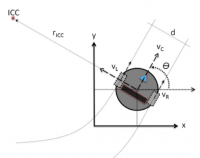Projects:2016s2-245 RFID in a Light Bulb
project team
Academic Supevisors
Dr. Said Al-Sarawi
Dr. Damith Ranasinghe
team members
ZEYU WANG RAN YE
Introduction
the development of a permanent power source for self-sustainable wireless sensor networks is essential in order to reduce the maintenance costs and increase the operational time of sensor nodes. Accordingly,over the past decade researchers have actively studied various energy harvesters that generate power form sources such as ambient light, heat, motion, electromagnetic waves and other unused sources of energy. One energy harvester driven by ambient vibrations has attracted special attention because it can easily gain energy form sources of movement such as human physical motion. This project states a liquid-based electrostatic energy harvester that converts the mechanical energy of human-motion-induced vibrations to electrical energy.
Aims
This paper presents a kinetic energy electrostatic harvester with electret as voltage source and liquid-based structure, which converts the mechanical energy in a low working frequency vibration to electrical energy. Moreover, it addresses the discharge issue of electret to improving charge storage stability of electrets in liquid-based environment. Extending from the theoretical research, the prototype of energy harvester is fabricated in proposed structure and is tested its performance in desirable low frequency range. In addition, the high efficiency circuit is necessary in energy conversion that is as important as the capacitor part.
Motivation and Significance
Energy harvesting technologies present a developing self-sustainable power source to replace conventional batteries in portable and low consumable application such as autonomous wireless sensor nodes, low power consumption electronic devices, and implantable medical equipment. As an emerging inexhaustible power source, there is significant developing potential in energy harvesting from ambient energy sources. It is different from piezoelectric harvesters and electromagnetic harvesters, which are mostly designed in a resonant mode and are driven in a relatively high frequency range. For instance, the spring structures are used in energy harvester should overcome their natural frequency to excite the system operation. Therefore, it is difficult to use in a low frequency range. Additionally, the electrets discharge reason limit their usage when it contacts with liquid. The polymer barrier layer is proposed to solve its discharge issue.
Comparing to conventional energy source, energy harvester provides sustainable and clean energy source. Comparing to piezoelectric energy harvester and electromagnetic energy harvester, electrostatic energy harvester has high output voltages; their components are built in low-cost parts, is easy to adjust the coupling coefficient and reaches high coupling coefficients, and increases capacitances through the reduction of size. These advantages are significant in small-scale energy harvester and in low frequency range operation.
The energy harvester needs an initial voltage. The conventional power supply is external power source such as battery and DC power supply, which are inconvenient in portable application, and it will affect the volume of entire energy harvester. And at the same time, the electret replaces these conventional power supply as initial voltage is a crucial part of this energy harvester.
background
Initially, the principle of energy harvester is capacitor. The components of liquid-based energy harvester are composed of two electrodes, which is top and bottom metal plates; a cavity is to store liquid; a Polytetrafluoroethylene (PTFE) film layer is coated on the bottom of cavity. A barrier layer is used to solve electret discharge issue. The electret is used to provide the initial voltage for energy harvester. And the conducting liquid plays a role in changing the way that the arrangement mode of inner capacitors.
In this capacitor, the electret and the covered film are considered as insulating layer. Through changing the liquid state, the inside structure of capacitor is changed when there is an external vibration. When the liquid occasionally contacts with the top insulating layer, the capacitance becomes large due to the air gap is eliminated. To be detailed, the inside structure of capacitor is changed from series capacitance to parallel capacitance. The value of capacitance is expressed as:
Capacitance initial is the minimum capacitance, capacitance excited is the maximum capacitance. ε1 is the permittivity of PTFE electret, ε2 is the permittivity of air, ε_3 is the permittivity of Cellulose Acetate tape. The d1 is the thickness of PTFE, d2 is the thickness of air gap, d3 is the height of liquid, d4 is the thickness of Cellulose Acetate tape. S is the overlay area of the top and bottom plates, Sliquid is the contact area of the conducting liquid and the insulating layer.
As this formula expressed, the electrical energy generation is determined by the capacitance ratio, the maximum capacitance and the electret voltage. As an important part of energy harvester, the electret is the core component of electrostatic energy harvester. It is a dielectric material, which has dipole polarisation or a permanent electric charge. It is similar like magnets that are dipoles. Many materials can be made into electret, most of them are made from synthetic polymers. It can be considered as stable direct current voltage source because there is a huge voltage potential in electret, which is an ideal alternative to DC voltage. However, the potential of electret is difficult to measure precisely at current stage, and it will decrease a lot in large time. The structure of energy harvester, the permittivity of insulating material and the voltage potential of electret are the most important three factors which affect the energy generation. Therefore, this paper will put emphasis on these three factors.
